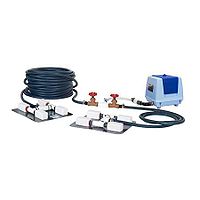Aeration Systems
An Aeration system can be for industrial aerators and diffused air systems. Aeration systems for powders are widely used throughout the world to effectively transport powders or as a discharge aid. Aeration Systems consist of aerating fountains, industrial aerators and diffused air systems. These aeration systems are widely used throughout the world to effectively manage the water quality of ponds and lakes. The aeration systems should not be confused with floating fountains.
Types
Large Aerating Fountains
Large Aerating Fountains are ideal for those seeking an impressive and generous fountain display with the benefits of aeration.
Industrial Aeration Systems
Industrial Aeration Systems provide unique solutions to managing water quality from low profile patterns to horizontal mixers and can be used in a variety of applications.
Diffused Pond Aeration System
Diffused Pond Aeration System uses on-shore compressors to pump air to diffusers located on the pond bottom. Quiet and extremely energy efficient this system creates no surface spray.
Common Characteristics
Continuous
To accomplish these great improvements over existing wastewater aeration systems, it had to operate continuously without failure.
Laminar Flow
For maximum efficiency, the diffused aeration needed to not stir up bottom muck and not mix phosphorus, nitrogen and other pollutants from the muck into the water column; wastewater aeration must not create turbulence. It must create a laminar flow of the water from the bottom to the surface without mixing bottom sediments in with the wastewater lagoon water.
Inversion
To duplicate nature, which kept lakes clean for thousands of years, the wastewater aeration system had to be properly engineered to duplicate spring and fall turnover, or inversion, of lakes several times a day. The reason for this is because our wastewater aerator brings water to the surface where it spreads out in a thin sheet 0.1 inches thick. Oxygen transfer from the atmosphere to the wastewater is then much higher than it is in standard clean water tanks, which have very low surface area.
Oxygenation
To bind phosphorus and nitrogen to the bottom sediment instead of re-suspending it into the water column, the wastewater aeration system had to be engineered to fully oxygenate the water from surface to bottom. It also had to oxygenate the bottom so bacteria and insects could feed on and biodegrade organic sediments and so anaerobic bacteria would not produce odors and toxic gases.
Video
